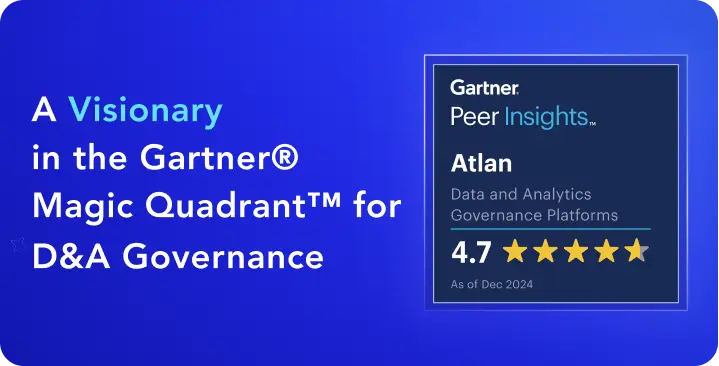Enterprise Data Catalogs: Attributes, Capabilities, Use Cases & Business Value
Share this article
An enterprise data catalog (EDC) provides you a holistic perspective of your data estate, enhancing data governance, democratization, analytics, BI, and metadata management.
The latest Forrester Wave™: Enterprise Data Catalogs, Q3 2024 report highlights that EDCs can bridge the gap between complex datasets, governance, business insights, and AI enablement.
This article will explore the core tenets of an enterprise data catalog, essential capabilities, use cases, and lastly, look at its business value.
Table of contents #
- What is an enterprise data catalog?
- The three vital attributes of an enterprise data catalog
- Essential capabilities of an enterprise data catalog
- Business value of enterprise data catalogs
- Atlan, an enterprise data catalog leader
- Related reads
What is an enterprise data catalog? #
An enterprise data catalog (EDC) helps you find, understand, and govern data assets across your organization.
Forrester defines an enterprise data catalog (EDC) as “a centralized repository that organizes metadata, lineage, and quality information.”
In the same report, Forrester also highlights that EDCs play a critical role in supporting business initiatives, such as:
- Data governance with centralized metadata management
- Self-service and analytics with intuitive UIs
- Risk mitigation with data lineage and quality
The three vital attributes of an enterprise data catalog #
According to Forrester’s Enterprise Data Catalogs Landscape, Q1 2024 report, the enterprise data catalog market has evolved into an established market because of surging demand for “data governance, regulatory compliance, and self-service.”
Currently, the EDC market has diverse vendors offering numerous core functionalities (metadata management, data profiling, collaboration) and catering to diverse user personas (stewards, analysts, business heads).
In such a diverse and competitive market, you should look for three vital attributes when evaluating EDCs:
- Automatically catalog the entire technology, data, and AI ecosystem
- Put AI and automation first
- Prioritize data democratization and self-services
Let’s explore the specifics.
1. Automatically catalog the entire technology, data, and AI ecosystem #
EDCs should adopt a holistic approach to mapping your entire data estate, leveraging automation to catalog data assets from all kinds of data sources, capture metadata, and chart out end-to-end, cross-system data lineage.
This approach is crucial to support modern data architectures (data fabric, data mesh) and unlock the full potential of data for decision-making.
2. Put AI and automation first #
Embedding AI, ML, and automation within an enterprise data catalog speeds up deployment and ensures a faster time-to-value.
For instance, capabilities such as AI-assisted data discovery, ML-driven profiling, automated anomaly detection, predictive tagging and proactive compliance reporting can improve data governance, quality, and compliance.
3. Prioritize data democratization and self-services #
Data catalog adoption and use is a major challenge that many organizations face. The biggest hurdles are a lack of personalized, user-friendly UIs, integration with diverse data tools, and a steep learning curve.
That’s why best-in-class EDCs that offer intuitive, simple UIs and a rich UX with natural language search and Gen AI have an edge.
Personalized views (think Netflix but for data user personas), interoperability with your favorite data tools, and self-service capabilities to find, understand, and use data can empower all data practitioners – technical and business – across your organization.
Next, let’s see how these attributes translate into core capabilities.
Essential capabilities of an enterprise data catalog #
Borrowing from the Forrester Wave™: Enterprise Data Catalog for DataOps, Q3 2024, an enterprise data catalog must offer the latest features for discovering and managing your data, such as:
- Metadata management that captures and manages all types of metadata (including custom metadata), while also handling:
- Automated data profiling (analyze data structure, quality, relationships, etc.)
- Classification and tagging
- Metadata augmentation
- Granular data lineage mapping (with impact and root cause analysis) and advanced lineage capabilities
- A UI that supports navigating, exploring, filtering, searching, and highlighting specific lineage elements along with overlayed metadata
- Capture and maintenance of data models, relationships, and mappings
- Automatic update and sync of metadata changes across your data estate
- Metadata inconsistencies between different data sources
- Data governance, risk, and compliance with:
- Granular access control and security
- Policy and process management
- Versioning
- Data privacy and security
- Ways to measure and communicate data governance, risk, compliance
- Automation to support governance, risk, compliance (for instance, identify, flag, remediate and/or recommend non-compliant data assets)
- Built-in support for risk assessment and regulatory compliance frameworks (GDPR, HIPAA, CCPA)
- Data democratization and self-service with:
- GenAI-assisted data discovery
- A frictionless UI/UX that provides personalization and collaboration (threads, comments, notes, user tagging, etc.) for technical and business users
- Collaboration tool interoperability (Jira, Teams, Slack, Trello, etc.)
- Data analytics and BI with intelligent data recommendations, proactive anomaly detection, monitoring and alerts, AI-assisted querying, etc.
- Out-of-the-box connectors for data products in your data stack — data sources, data movement tools, BI tools, and more
- Data products supported (for example, sources, tables, pipelines, policies, data models, etc.) with effective management that includes data product lifecycle, prioritization, access, rights management, etc.
- Marketplace and exchange – ways in which the enterprise data catalog enables data clean rooms, data monetization, and collaboration and sharing with external stakeholders
- Ease of deployment (on-premise, public cloud, SaaS, multi-cloud, etc.), adoption (look for the median timeline from kickoff to go-live), and faster time-to-value (with unique accelerators, capabilities, or contents)
- Data quality (with real-time monitoring of DQ metrics and KPIs) and observability to ensure the trustworthiness of data
- Workflow and task management with custom workflow configurations
- Real time, IoT, and edge support
Business value of enterprise data catalogs #
An enterprise data catalog can save costs and time, improves efficiency, simplifies governance, and helps you make faster decisions, which translate to better innovation, implementation, and a lower probability of lost opportunities.
Let’s look at three large enterprises with complex data ecosystems to understand the business value of EDCs.
Nasdaq #
Financial and technology heavyweight Nasdaq is the world’s second-largest exchange with $18 trillion in market capitalization. Nasdaq wanted to better support its business partners by modernizing its data stack and building a data-first culture.
“A third of their (Nasdaq’s power users) time every week is spent just trying to understand what is there. Imagine if we could bring a product in that helps reduce that effort and really enables them to get right to the heart of the problem — to drive data products from insights into the business.” Michael Weiss, Product Manager at Nasdaq
That’s where Atlan, named a leader in Forrester’s latest Wave™ report for EDCs, fits into the Nasdaq ecosystem. Adopting Atlan was like having Google for Nasdaq’s data, catalyzing a common understanding of their data and the tools at their disposal.
General Motors #
General Motors had an effective on-premise infrastructure that served its purpose for GM’s data practitioners. However, when GM conducted a time-in-motion study, they discovered that they spent 200 person years hunting and gathering data.
More importantly, according to Brian Ames (Head of AI Center at GM) observed that, “if we didn’t have AI and ML in our arsenal, we could find ourselves at a competitive disadvantage.”
To improve efficiency and drive innovation, GM built a Data Insights Factory, partnering with Databricks, Immuta, and Atlan – for governance and end-to-end visibility across their cloud and on-prem infrastructure.
As a result, GM now has:
- 50+ data and AI use cases in production
- 2,100+ users accessing insights monthly
- A reduction in time-to-insight from 28 days to less than 3 hours
- $330M in bottom line unlocked
Autodesk #
Autodesk, a global leader in design and engineering software and services, wanted to implement the data mesh strategy to scale its data and analytics use cases.
They needed an enterprise data catalog that provided a simple way to discover, understand, trust, and use data products and decided to adopt Atlan.
“Atlan is the primary consumption layer that brings a lot of the metadata that publishers provide to the consumers, and it’s where consumers can discover and use the data they need.” Mark Kidwell, Chief Data Architect, Data Platforms and Services
Atlan, an enterprise data catalog leader #
If you are evaluating an enterprise data catalog solution for your business, consider giving Atlan a go. The latest Forrester report (The Forrester Wave™: Enterprise Data Catalogs, Q3 2024) named Atlan a leader in EDCs, scoring highest for Current Offering and Strategy.
“Atlan is a visionary player with a clear, ambitious goal: to become the data and AI control plane enabling complex business use cases. Organizations aiming for democratization and AI-enhanced self-service to governed data will find Atlan to be an unparalleled partner.” The Forrester Wave™: Enterprise Data Catalogs, Q3 2024
Atlan enjoys deep integrations and partnerships with best-of-breed solutions across the modern data stack. Check out our connectors here.
Atlan already enjoys the love and confidence of some of the best data teams in the world including WeWork, Postman, Monster, North American Bancard, and Ralph Lauren — to name but a few. Check out what our customers have to say about us here.
Enterprise data catalogs: Related reads #
- What Is a Data Catalog? & Do You Need One?
- Data catalog benefits: 5 key reasons why you need one
- Open Source Data Catalog Software: 5 Popular Tools to Consider in 2024
- Data Catalog Platform: The Key To Future-Proofing Your Data Stack
- Top Data Catalog Use Cases Intrinsic to Data-Led Enterprises
- Best Alation Alternative: 5 Reasons Why Customers Choose Atlan
- AWS Glue Data Catalog: Architecture, Components, and Crawlers
- Airbnb Data Catalog — Democratizing Data With Dataportal
- Lexikon: Spotify’s Efficient Solution For Data Discovery And What You Can Learn From It
Share this article











